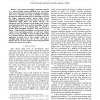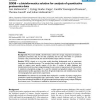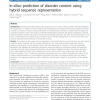311 search results - page 36 / 63 » Statistical significance in biological sequence analysis |
SADM
2010
13 years 6 months ago
2010
: Seriation is an exploratory combinatorial data analysis technique to reorder objects into a sequence along a one-dimensional continuum so that it best reveals regularity and patt...
CIBCB
2006
IEEE
14 years 1 months ago
2006
IEEE
— DNA sequence basecalling is commonly regarded as a solved problem, despite significant error rates being reflected in inaccuracies in databases and genome annotations. These er...
BMCBI
2010
13 years 7 months ago
2010
Background: Alternative splicing is an important mechanism that increases protein diversity and functionality in higher eukaryotes. Affymetrix exon arrays are a commercialized pla...
BMCBI
2006
13 years 7 months ago
2006
Background: We present 2DDB, a bioinformatics solution for storage, integration and analysis of quantitative proteomics data. As the data complexity and the rate with which it is ...
BMCBI
2011
12 years 11 months ago
2011
Background: Intrinsically disordered proteins play important roles in various cellular activities and their prevalence was implicated in a number of human diseases. The knowledge ...



